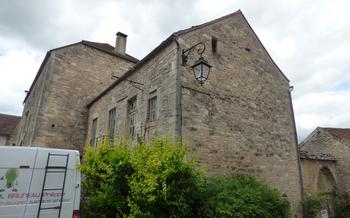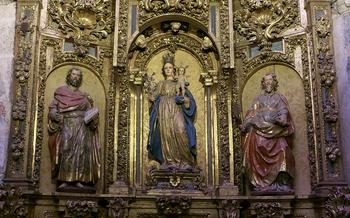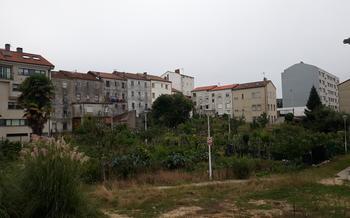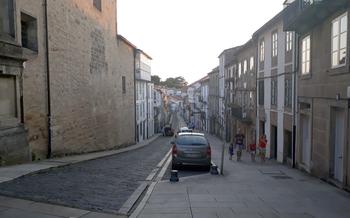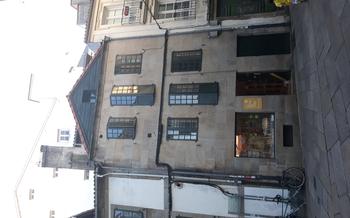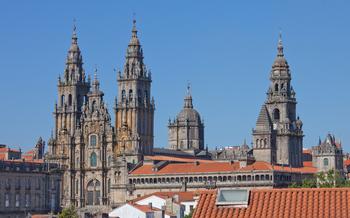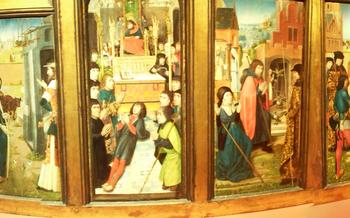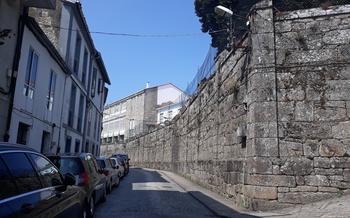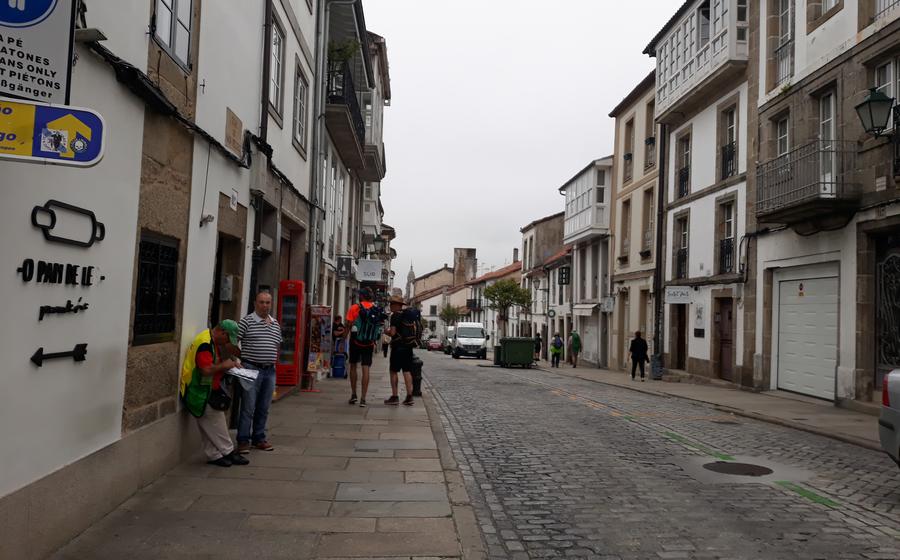
Capilla de Ánimas Chapel dedicated to the souls in purgatory
- Location and Accessibility
- Interior Design and Architecture
- The Souls in Purgatory
- Devotion and Pilgrimage
- Cultural Significance
- Restoration and Preservation
- Visiting Hours and Information
- Historical Importance
- Legends and Myths
- Artistic Treasures
- Unique Features
- Surrounding Area
- Personal Experiences
- Insider Tip:
Location and Accessibility
The Capilla de Ánimas is conveniently situated in heritage. It occupies a prominent position on the Plaza de las Platerías, a picturesque square located just steps away from the iconic Santiago Cathedral. The surrounding area is brimming with architectural wonders, historical landmarks, and lively cafes, making it an ideal starting point for exploring the city's many treasures.
Reaching the chapel is a breeze, as it is easily accessible on foot from most parts of the city center. For those arriving by car, there are several nearby parking options available. Visitors can also take advantage of the city's excellent public transportation system, with bus stops conveniently located within walking distance of the chapel. The Capilla de Ánimas is fully accessible to visitors with disabilities, featuring wheelchair ramps and accessible entrances.
Interior Design and Architecture
The Capilla de Ánimas boasts a captivating interior that harmoniously blends architectural grandeur with religious symbolism. Its layout is characterized by a single nave, creating a sense of intimacy and devotion. The walls are adorned with intricate carvings and sculptures that depict scenes from the Bible and the lives of saints, adding a layer of visual interest to the chapel's interior.
One of the most striking features of the chapel is its vaulted ceiling, which is adorned with beautiful frescoes depicting scenes from the afterlife and the souls in purgatory. These frescoes serve as a reminder of the chapel's primary purpose and create a sense of awe and contemplation within the space.
The altar is the focal point of the chapel, featuring a stunning altarpiece dedicated to the souls in purgatory. The altarpiece is intricately carved and decorated with gold leaf, creating a sense of opulence and reverence. The altar is also adorned with candles, which visitors can light to pray for the souls in purgatory and seek their intercession.
The Capilla de Ánimas is a testament to the skill and artistry of its builders and decorators. Every element of its interior design, from the vaulted ceiling to the intricate carvings, has been carefully crafted to create a sacred and inspiring space that invites visitors to contemplate the mysteries of life, death, and the afterlife.
The Souls in Purgatory
In Catholic theology, purgatory is a state of purification for the souls of those who have died in a state of grace but with temporal punishment still due for their sins. According to Catholic belief, these souls are destined for Heaven but must first undergo a period of purification to remove the remaining imperfections and attachments that prevent them from entering the fullness of God's presence.
The Capilla de Ánimas plays a significant role in praying for the souls in purgatory. It is believed that prayers offered in this chapel can help alleviate the suffering of these souls and hasten their journey to Heaven. Many pilgrims visit the chapel specifically to pray for the deceased, whether it be their loved ones or those who have no one to pray for them.
There are numerous stories and anecdotes related to the souls in purgatory and the Capilla de Ánimas. One such story tells of a pilgrim who visited the chapel and prayed fervently for the soul of a deceased friend. As the pilgrim prayed, they heard a voice whispering their friend's name, reassuring them that their prayers were being heard and that their friend was grateful for their intercession.
The significance of praying for the deceased in Catholic tradition cannot be overstated. Catholics believe that the souls in purgatory can benefit from the prayers of the living and that these prayers can help them reach eternal salvation. Visiting the Capilla de Ánimas and praying for the souls in purgatory is a powerful way to demonstrate one's faith and love for the deceased.
Devotion and Pilgrimage
The Capilla de Ánimas holds a profound significance as a place of devotion and pilgrimage for Catholics worldwide. Pilgrims from various corners of the globe flock to this sacred site, drawn by its reputation for aiding the souls trapped in purgatory. Visitors often light candles, recite prayers, and offer supplications for the deceased, seeking divine intervention and solace. The chapel exudes an aura of spirituality, inviting pilgrims to immerse themselves in contemplation, reflection, and communion with the departed souls.
One of the most common rituals associated with the chapel is the "Way of the Souls," a devotional practice involving walking a specific route while praying for the souls in purgatory. Pilgrims undertake this symbolic journey in the belief that it helps alleviate the suffering of the deceased and hastens their passage to heaven. The Capilla de Ánimas serves as a powerful reminder of the interconnectedness of life and death, encouraging visitors to embrace the Catholic tradition of praying for the deceased and seeking their intercession.
Cultural Significance
The Capilla de Ánimas holds a profound cultural significance within Santiago de Compostela. It is deeply ingrained in the local traditions and customs, serving as a symbol of the city's rich spiritual heritage. The chapel is a popular destination for pilgrims and tourists alike, who come to pay their respects and seek solace within its sacred walls.
One of the most notable cultural events associated with the chapel is the annual Procession of the Souls in Purgatory. Held every year on the evening of November 2nd, this solemn procession sees hundreds of people carrying candles and singing hymns as they make their way through the streets of Santiago, culminating at the Capilla de Ánimas. This moving ceremony is a testament to the enduring devotion to the souls in purgatory and the deep cultural significance of the chapel in the city.
Another cultural aspect of the Capilla de Ánimas is its role in local folklore and legends. Many stories and myths surround the chapel, adding to its mystique and allure. One popular legend tells the tale of a young woman who was unjustly accused of a crime and imprisoned. She prayed fervently to the souls in purgatory for help, and they miraculously freed her from her chains. In gratitude, she dedicated the rest of her life to helping the poor and needy, becoming a symbol of compassion and redemption.
Restoration and Preservation
Throughout its existence, the Capilla de Ánimas has undergone several restoration and preservation efforts to maintain its architectural integrity and historical significance. One of the most notable restorations took place in the 19th century when the chapel's exterior was renovated, and its interior was embellished with new paintings and sculptures. In the 20th century, further restoration work was carried out to address structural issues and ensure the chapel's stability.
Preserving the unique features of the Capilla de Ánimas presents several challenges. The chapel's age and exposure to the elements have caused deterioration over time, requiring careful attention to maintain its original appearance. Additionally, the chapel's intricate carvings and delicate artwork require specialized conservation techniques to prevent further damage.
Ongoing conservation work is crucial to ensuring the Capilla de Ánimas remains a cherished landmark for generations to come. Skilled artisans and conservators work tirelessly to restore and maintain the chapel's architectural elements, paintings, and sculptures, using traditional methods and materials to preserve its historical authenticity.
One of the most successful restoration stories involves the intricate carvings on the chapel's facade. Over time, these carvings had become weathered and eroded, obscuring their original details. Through painstaking efforts, skilled artisans were able to restore the carvings to their former glory, revealing the intricate scenes and figures that adorn the chapel's exterior.
The preservation of the Capilla de Ánimas is a testament to the dedication and expertise of those committed to safeguarding its historical and cultural significance. Ongoing restoration and conservation efforts ensure that this unique chapel continues to stand as a symbol of faith, devotion, and the enduring spirit of Santiago de Compostela.
Visiting Hours and Information
Visiting the Capilla de Ánimas is a unique and awe-inspiring experience. It is open to the public at specific times and days. Currently, visitors can explore the chapel from [Insert Opening Hours] on [Insert Opening Days].
Admission to the Capilla de Ánimas is free of charge, allowing everyone the opportunity to experience its spiritual and historical significance. It is advisable to plan your visit during non-peak hours to avoid crowds and fully immerse yourself in the chapel's serene atmosphere.
Before visiting, it is essential to dress respectfully, as the chapel is a sacred space. Comfortable shoes are recommended as you may want to spend time exploring the surrounding area and appreciating the beauty of Santiago de Compostela.
For further inquiries or to stay updated on any changes in visiting hours or events, please visit the official website of the Capilla de Ánimas. Join the many pilgrims and visitors who have experienced the profound spiritual connection within this extraordinary chapel.
Historical Importance
The Capilla de Ánimas holds immense historical significance within the tapestry of Santiago de Compostela's rich past. It stands as a testament to the city's deep-rooted religious traditions and has played a pivotal role in countless religious and cultural events throughout the centuries.
In the annals of history, the chapel has witnessed countless moments of profound devotion and spirituality. It has served as a sanctuary for pilgrims seeking solace and guidance as they traversed the arduous Camino de Santiago. Kings, queens, and nobles have graced its hallowed halls, offering their prayers and paying homage to the souls in purgatory.
One notable figure associated with the chapel is Archbishop Pedro Muñiz de Godoy, who is credited with its construction in the 16th century. His vision and dedication transformed a simple hermitage into the exquisite chapel we see today, adorned with elaborate carvings and intricate artwork.
Over the centuries, the Capilla de Ánimas has withstood the test of time. It has survived wars, fires, and natural disasters, emerging as an enduring symbol of faith and resilience. Its historical importance is deeply intertwined with the city's identity, making it an integral part of Santiago de Compostela's cultural heritage.
Legends and Myths
The Capilla de Ánimas is shrouded in a veil of legends and myths that have captivated the imaginations of pilgrims and locals for centuries. One of the most enduring legends tells of a group of souls who were trapped in purgatory, unable to find peace due to their unresolved sins. These souls appeared to a pious man named Juan Fernández, pleading for his help in freeing them from their torment.
Fernández, moved by their plight, dedicated himself to praying for the souls in purgatory. He spent countless hours within the chapel, offering prayers and masses for their release. His unwavering devotion eventually touched the hearts of the souls, who were finally able to ascend to heaven. In gratitude, they left behind a miraculous imprint of their hands on the chapel's walls, a testament to the power of prayer and intercession.
Another legend associated with the chapel speaks of a mysterious benefactor who appeared during its construction. This enigmatic figure provided the necessary funds to complete the chapel, but on the condition that his identity would remain a secret. Despite numerous attempts to uncover his true identity, the benefactor's name remains unknown, adding to the chapel's aura of mystery and intrigue.
These legends and myths have played a significant role in shaping the reputation and significance of the Capilla de Ánimas. They have contributed to its status as a sacred and revered site, attracting pilgrims and visitors from all corners of the world who seek solace, inspiration, and a connection to the divine.
Artistic Treasures
Within the Capilla de Ánimas, visitors can marvel at a collection of remarkable artworks that add to the chapel's spiritual and cultural significance. The most notable piece is the altarpiece, a masterpiece of Baroque art created by the renowned sculptor, José Gambino. The intricate carvings and gilded details depict scenes from the life of Christ and the souls in purgatory, capturing the essence of the chapel's devotion and purpose. Other notable works include a series of 17th-century paintings by local artists, each depicting a soul in purgatory being released from their suffering through the prayers of the faithful. These artworks serve as a powerful reminder of the chapel's mission and the transformative power of prayer.
Unique Features
The Capilla de Ánimas stands out from other chapels with its unique architectural features and artistic elements. One of its most distinctive characteristics is the intricate stonework that adorns the exterior. The facade boasts a beautiful rose window, while the walls are adorned with delicate carvings depicting scenes from the Bible. Inside the chapel, visitors can admire the stunning altarpiece, featuring intricate carvings and vibrant colors. The chapel's vaulted ceiling is adorned with frescoes depicting scenes from the life of Christ and the saints. These unique artistic treasures contribute to the chapel's serene and inspiring atmosphere, making it a must-visit for anyone interested in art and architecture.
Surrounding Area
The Capilla de Ánimas is situated in the chapel's surroundings offer visitors a glimpse into the city's rich heritage and vibrant culture. A short stroll from the chapel, visitors can explore the stunning Plaza del Obradoiro, the epicenter of the city and home to the majestic Santiago Cathedral. The plaza is a UNESCO World Heritage Site and a popular gathering spot for pilgrims and tourists alike.
Just around the corner from the Capilla de Ánimas is the Mercado de Abastos, a lively market where locals and visitors can shop for fresh produce, seafood, and traditional Galician delicacies. The market is a feast for the senses, with colorful stalls displaying an array of local products and the air filled with the sounds and smells of the bustling marketplace.
For those seeking a tranquil retreat, the Parque de la Alameda, located a short walk from the chapel, offers a serene oasis amidst the city's vibrant energy. This beautiful park, with its lush gardens, tranquil ponds, and historic monuments, is a popular spot for locals and visitors to relax, stroll, or enjoy a picnic.
The surrounding area of the Capilla de Ánimas is a treasure trove of historical and cultural gems, waiting to be explored. Visitors can immerse themselves in the city's rich past by visiting the Museo das Peregrinacións, which showcases the history of pilgrimage to Santiago de Compostela, or the Museo do Pobo Galego, which offers a glimpse into the region's ethnography and traditions.
To make the most of your visit to the Capilla de Ánimas and its surroundings, consider exploring the city on foot. Santiago de Compostela is a pedestrian-friendly city, and many of its most notable landmarks are within easy walking distance of the chapel. As you wander through the city's charming streets, be sure to take in the unique atmosphere, admire the historical architecture, and savor the vibrant energy that makes Santiago de Compostela a truly special destination.
Personal Experiences
My visit to the Capilla de Ánimas was a profound and moving experience. As I stepped inside the dimly lit chapel, I was struck by the sense of peace and tranquility that permeated the air. The soft glow of the candles illuminated the intricate carvings and sculptures that adorned the walls, casting an ethereal glow on the interior.
I spent several moments in quiet contemplation, reflecting on the countless souls who had found solace and comfort within these walls. The stories of those who had lost loved ones and sought solace in prayer resonated deeply with me, and I couldn't help but feel a sense of connection to their journey.
As I left the chapel, I carried with me a newfound appreciation for the significance of this sacred space. The Capilla de Ánimas is a testament to the enduring power of faith and the human spirit's ability to find hope and healing even in the darkest of times.
Insider Tip:
For an unforgettable experience, visit the Capilla de Ánimas at dusk when the fading light casts a warm glow on its intricate facade. Take your time to explore the chapel's dimly lit interior, allowing the serene atmosphere to envelop you. The flickering candlelight creates a mystical ambiance, enhancing the chapel's spiritual significance. This is the perfect time to reflect on the souls in purgatory and the power of prayer. Remember, the Capilla de Ánimas is not just a historical monument but a sacred space that invites contemplation and spiritual connection.
